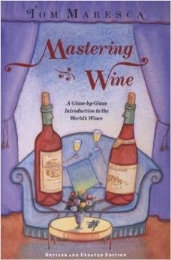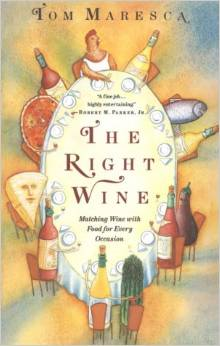The protagonist of Martin Walker’s mystery series, chief of police in a small Périgord town, is known to me as “Bruno, Chef de Cuisine,” because he spends as much time cooking as he does detecting. My beloved spouse, who consumes mystery novels the way other people eat candy, has needless to say noted this aspect of the stories and has in fact re-created for her blog several of Bruno’s feasts.
Most recently, she and her co-conspirator Hope put together one such dinner that required serious white wine accompaniment. That, of course, became my problem, and problem it was. Neither my household supply nor my local retail shops provided the sort of very localized Périgord wines that Bruno delights to serve. I had to be creative and find some that I hoped would be equivalent wines to match with Bruno’s – and Diane’s and Hope’s – dishes. You can see the details of the dinner in Diane’s blog. The wines I chose to accompany it were a Mâcon blanc, a Condrieu, and a Savennières.
.
My first problem was that the author was not entirely helpful in talking about Bruno’s wines. He described only two bottles, which I can’t imagine would have been sufficient in kind or quantity for the variety of dishes and number of guests. His first wine was a Château du Rooy Bergerac blanc, a blend of to-me-unknown-percentages of Sauvignon blanc, Sémillon, and Muscadelle. Insofar as this was served as an apéritif with a splash of cassis – a kir – it presented no difficulties. All I needed for that was a good basic white wine, not too fruit-forward and with decent acidity, so almost any well-made simple white Burgundy would serve well. I had on hand a nice 2019 Mâcon-Villages from Michel Barraud that fit the bill perfectly, and made a beautifully refreshing kir to accompany a warm summer afternoon’s cooking.
.
The same wine, minus the cassis, seems to have served Bruno as the first dinner wine, and this presented a bit more of a challenge. Bruno’s wine would have had a distinctive, spicy character, with – I’m guessing because he was serving it with foie gras – suggestions of sweetness without any actual sugar presence. Condrieu, with its rich Viognier character, suggested itself, and I was lucky enough to have lurking in my “cellar” a bottle of 2016 Condrieu La Chambée from Les Vins de Vienne.
Condrieu is a tiny appellation, and this wine is sourced from just two hectares of vineyards at different spots within it. It’s 100% Viognier, laboriously farmed on steep and rocky slopes above the Rhône by three devotees who make up the winery.
.
The wines of Condrieu are famed for their complexity, depth, and distinctive combination of minerality and spicy fruit in the nose and on the palate. All that makes it a natural choice to accompany foie gras, exactly the sort of wine I think Bruno (or Martin Walker) would have chosen. Ours did not disappoint: Indeed, it made us aware how far short of foie gras our otherwise fine pâté de campagne fell. Memo to self: get more Condrieu, and above all, find some foie gras.
.
Our third wine presented the greatest challenge of all: The only other wine mentioned at Bruno’s dinner (a gift from his guest the Baron) was from Vignobles Les Verdots, again a white Bergerac, vinified from approximately two-thirds Muscadelle and one-third Sauvignon gris. The producer’s website, not very modestly, says of it:
This wine figures among the great white wines of France. Rich, spicy, with mineral and fruit notes on the nose, a whiff of smoke and lightly toasted too. The palate is generous in aromas and flavor, with good body, minerality, well-balanced and exceptionally long. It is also elegantly packaged.
This bottle would have been served with Bruno’s main course of braised chicken in a wine, tarragon, and cream sauce. Now there’s a challenge!
I had a wine that, mutatis mutandis, might fit that description, but I’ve had it around for a while and I was beginning to worry about its soundness: a 2003 Coulée de Serrant Savennières from Nicolas Joly. I decided to give it a shot.
All Savennières wines are special: They originate only in a tight little zone of steep hills in the middle Loire, where the Chenin blanc from which they are exclusively vinified reaches heights of flavor and depths of character attainable nowhere else.
.
.
Also, Savennières ages remarkably well, growing deeper and more profound for many years – though I was more than a little nervous, given the deficiencies of my storage, whether I might have gone too long with this particular bottle.
Another also: The winemaker, Nicolas Joly, is a bit of a wild man. The most famous grower of the zone, he was the first there to go biodynamic, and he did so with a vengeance: natural fertilizers spread by hand from cow horns on nights of the full moon – that sort of thing.
So my bottle of Savennières was sure to be memorable: the question was whether that would be for good or for ill.
Appearances didn’t answer that: a very dark, old gold color didn’t tell us anything. The nose, however did, and the news was good: exotic aromas, of earth and mineral and woodruff and dried cranberry (yes!) indicated the wine was very much alive. The first taste confirmed it, the same elements as in the nose wrapped in a silken package, smooth on the palate, leaving an impression of great suavity and a finish that went on and on.
A totally distinctive wine, that not only went beautifully with our version of Bruno’s chicken dish but also made me wonder how it would taste with good bloc foie gras. Must get some foie gras! Bruno is a very lucky man, with his seemingly endless local supply.







